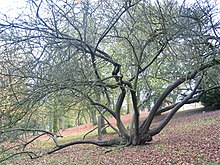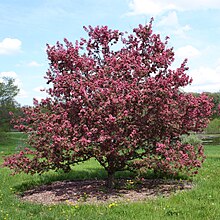
Hi Everybody!!
Today some fruity flowers join the Spring Parade of Blooms! When I see these beautiful apple blossoms, I also imagine the apple pie I will be making this summer. Somehow seeing the flowers, then the baby apples growing, adds to the excellent taste! The photostudy below shows several fruit trees starting their spring bloom. I have included links to Wikipedia Pages for more info about these trees. I encourage you all to plant fruit trees.(Check what will grow in your area). I add new baby trees every year. Enjoy!

link to G+ Photo Album:
https://plus.google.com/u/0/photos/117645114459863049265/albums/6123944840890542337

https://en.wikipedia.org/wiki/Granny_Smith
The Granny Smith is a tip-bearing apple cultivar, which originated in Australia in 1868.[1] It is named after Maria Ann Smith, who propagated the cultivar from a chance seedling. The tree is thought to be a hybrid of Malus sylvestris, the European Wild Apple, with the domestic apple M. domestica as the polleniser. The fruit has hard, light green skin and a crisp, juicy flesh.
| Malus 'Granny Smith' | |
|---|---|
 | |
| Hybrid parentage | Thought to be Malus domestica × M. sylvestris |
| Cultivar | Granny Smith |
| Origin | Maria Ann Smith Australia, 1868 |

Honeybee pollinating flower


Purple Leaf Plum Tree blooms


https://en.wikipedia.org/wiki/Cherry_plum
Prunus cerasifera is a species of plum known by the common names cherry plum and myrobalan plum.[2] It is native to Europe[3] and Asia.[2]
Wild types are large shrubs or small trees reaching 6-15 m tall, with deciduous leaves 4-6 cm long. It is one of the first European trees to flower in spring, often starting in mid-February. The flowers are white and about 2 cm across, with five petals. The fruit is a drupe, 2-3 cm in diameter, and yellow or red in colour. It is edible, and reaches maturity from early July to mid-September.
This species can be found growing wild where it has escaped cultivation and become naturalized, such as in North America.[4][5]
Cultivated cherry plums can have fruits, foliage, and flowers in any of several colors. Some varieties have sweet fruits that can be eaten fresh, while others are sour and better for making jam.
Cherry plums are a key ingredient in Georgian cuisine where they are used to produce tkemali sauce, as well as a number of popular dishes, such askharcho soup and chakapuli stew.
The cherry plum is a popular ornamental tree for garden and landscaping use, grown for its very early flowering. Numerous cultivars have been developed, many of them selected for purple foliage, such as 'Atropurpurea'.[6][7] These purple-foliage forms (often called purple-leaf plum), also have dark purple fruit, which make an attractive, intensely coloured jam. They can have white or pink flowers. The cultivar 'Thundercloud' has bright red foliage which darkens purple.[8] Others, such as 'Lindsayae', have green foliage. Some kinds of purple-leaf plums are used for bonsai[7] and other forms of living sculpture.
The variety 'Nigra' with black foliage and pink flowers, has gained the Royal Horticultural Society's Award of Garden Merit.[9]
The cherry plum has been listed as one of the 38 plants that are used to prepare Bach flower remedies,[10] a kind of alternative medicine promoted for its effect on health. However according to Cancer Research UK, "there is no scientific evidence to prove that flower remedies can control, cure or prevent any type of disease, including cancer".[11]
| Cherry plum | |
|---|---|
 | |
| Scientific classification | |
| Kingdom: | Plantae |
| (unranked): | Angiosperms |
| (unranked): | Eudicots |
| (unranked): | Rosids |
| Order: | Rosales |
| Family: | Rosaceae |
| Genus: | Prunus |
| Subgenus: | Prunus |
| Section: | Prunus |
| Species: | P. cerasifera |


https://en.wikipedia.org/wiki/American_yellow_warbler
The American yellow warbler (Setophaga petechia, formerly Dendroica petechia) is a New World warbler species. Sensu lato, they make up the most widespread species in the diverse Setophaga genus, breeding in almost the whole of North America and down to northern South America.
| American yellow warbler | |
|---|---|
 | |
| Male in breeding plumage, Canada | |
| Conservation status | |
| Scientific classification | |
| Kingdom: | Animalia |
| Phylum: | Chordata |
| Class: | Aves |
| Order: | Passeriformes |
| Family: | Parulidae |
| Genus: | Setophaga |
| Species: | S. petechia |






Crab Apple Blooms
https://en.wikipedia.org/wiki/Malus
Malus (/ˈmeɪləs/[3] or /ˈmæləs/), apple, is a genus of about 30–55 species[4] of small deciduous trees or shrubs in the family Rosaceae, including the domesticated orchard apple (M. domestica). The other species are generally known as crabapples, crab apples, crabs, or wild apples.
| Malus | |
|---|---|
 | |
| Malus 'Purple Prince'[1] | |
| Scientific classification | |
| Kingdom: | Plantae |
| (unranked): | Angiosperms |
| (unranked): | Eudicots |
| (unranked): | Rosids |
| Order: | Rosales |
| Family: | Rosaceae |
| Subfamily: | Amygdaloideae[2] |
| Tribe: | Maleae |
| Subtribe: | Malinae |
| Genus: | Malus |


Apricot Tree
https://en.wikipedia.org/wiki/Apricot
An apricot is a fruit or the tree that bears the fruit. Usually, an apricot tree is from the tree species Prunus armeniaca, but the species Prunus brigantina, Prunus mandshurica, Prunus mume, and Prunus sibirica are closely related, have similar fruit, and are also called apricots.[1]




Cherry Plum Blooms


,,,this is brendasue signing off from Rainbow Creek. See you next time!

O+O


Hello
ReplyDeleteThank you for sharing this information
Regards
Best Lawn Maintenance Company In India